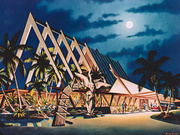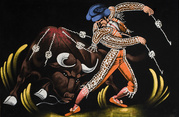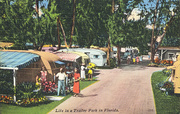
Swizzle sticks organized by color, from the collection of Pam Ashlund.
Lots of people are swizzle-stick collectors but don’t even know it. The bulk of your collection is probably hiding in the back of your junk drawer, and you might find one or two more sticks jammed amid the dry felt-tip pens in that jelly jar on the credenza, next to the spot where your landline used to be. Not to put too fine a point on it, but inventorying your swizzle-stick collection could be as easy as tidying up a bit around the house.
“I treasured those swizzle sticks as a kind of family heirloom.”
Pam Ashlund knows exactly where all 50,000 or so of her swizzle sticks are. That’s because she currently shares her home outside of Los Angeles with about 100 Tupperware containers, each of which is filled to the brim with plastic, wood, glass, and metal sticks designed to agitate alcohol and ice cubes. She’s currently writing a book on the subject, and she’d like to open a museum devoted to these diminutive utensils, from their history and means of manufacture to the stories of the places they came from, places where people used to enjoy just hanging out and sipping, as one swizzle-stick collector put it to Ashlund, “drinks with sticks in ’em.”
Ashlund started collecting swizzle sticks because of her mother, although, she hastens to clarify when we speak over the phone, her mom was not, and is not, a swizzle-stick collector. As for her father, “he calls them ‘those sticks,’” Ashlund says. “He remembers getting them in drinks in dive bars, and then chewing on them. So he’s like, ‘Why would you ever want something that someone had put in their mouth?’ He’s never been able to get over that mental picture enough to even look at them.”

Pam Ashlund’s first swizzle stick was a yellow Skully from the Ivanhoe, a famous restaurant and bar in Chicago, given to her by her mom. The people who ran the Ivanhoe eventually made Skullys in numerous colors, three of which are shown here. Via swizzlestickcollectors.com.
In fact, bars are the primary source for most of the world’s collectible swizzle sticks. “In the 1950s,” Ashlund says, “when you went to a restaurant or bar, you’d bring home a swizzle stick as a memento, similar to collecting matchbooks picked up while on vacation. People would keep them, and somewhere in the house they’d end up with a little cup full of swizzle sticks.”
The swizzle-stick cup at Ashlund’s parent’s home in the South Shore neighborhood of Chicago doubled as a pencil jar. The family cache of swizzle sticks was so unremarkable, Ashlund doesn’t even remember noticing them as a child, but when she was visiting her parents in 2007, the sticks captured her imagination. She describes the encounter in her forthcoming book:
“My mother grew up in the shadow of the Great Depression. Nothing was wasted. Nothing was thrown out, especially rubber bands. And also pens and pencils. It was among these pens and pencils that I came across my first swizzle stick: A pale yellow stick with a skull on one end and a bone on the other. The stick was from the Ivanhoe, which had been a medieval-themed restaurant (dining, dancing, and entertainment) in the 1950s in Chicago. Mom told me about going on a double date there. She remembered a Hall of Knights Armor and dancing until the wee hours. I asked if I could bring the stick home and she agreed. I didn’t know it then, but I had been bitten by the collector bug.”

Recently, Pam Ashlund organized a very small part of her collection into a mini-exhibition in her office at the Natural History Museum of Los Angeles County.
Ashlund returned to Southern California with several “Skully” swizzle sticks, as she calls them, but unfortunately all of them were stolen during a burglary in 2009. “I treasured those swizzle sticks as a kind of family heirloom,” she writes, “so I kept them tucked away in a drawer with my jewelry.”
The jewelry turned out to be replaceable, but Ashlund remained troubled by the loss of her cache of Skullys, so, eventually, in 2012, she headed online, where she found another Skully on eBay. It was in an ivory hue rather than yellow like the ones she got from her mom, and she had to buy a group of 60 sticks to get it. But for $12, her family heirloom had basically been replaced. “At that point,” Ashlunds says, “I knew I was a goner.”
It wasn’t just the swizzle sticks that intrigued Ashlund; she was equally taken by the community of people who loved them. That introduction came during her search for a replacement Skully, when Ashlund happened upon a curious little website, whose design and underlying code was probably circa 1993, promoting the activities of an organization called the International Swizzle Stick Collectors Association, or ISSCA.

A detail from Ashlund’s mini-exhibition of swizzle sticks.
The quaint charm of site’s vintage graphics aside, Ashlund was startled to learn that since its founding in 1985, the group had been publishing a 40-page monthly newsletter about swizzle sticks. Yes, you read that right—40 pages a month solely on the subject of swizzle sticks and the important business of the ISSCA, from news about an upcoming convention and to the association’s financial statements (let the record show that as of 12/31/88, the ISSCA had a bank balance of $1,886.90). “It was just so insane,” Ashlund tells me, “the whole thing seemed preposterous. I had to know who would write 40 pages a month about swizzle sticks”
The answer was a man from Vancouver, B.C., named Ray Hoare, who had joined forces with another swizzle-stick collector, Polly Rusk, of Yuma, Arizona, to create the ISSCA. Ashlund promptly ordered every back issue of the newsletter she could, at a cost of $1.50 each. “Three 35-pound boxes arrived at my door,” she remembers. “The postage was $99.” After Ray died in 2014, his wife, Vera, who had been a founding member of the group with her husband, encouraged Ashlund to take over the organization’s newsletter duties, which Ashlund has been writing for the association’s new website since 2016, albeit not at 40 pages a crack, and quarterly rather than monthly.

The ideal swizzle sticks made from a twig taken from Quararibea turbinata, a.k.a. the swizzle-stick tree, has small branches on one end to aide swizzling. Via swizzlestickcollectors.com.
One of the first things Ashlund learned about swizzle sticks is where the word “swizzle” came from. According to an article by Dom Pennock published in 2017 on the ISSCA’s website, back in the 18th century, people in the Caribbean drank a drink called swizzle, which consisted of water mixed with a small amount of rum. It was customary to stir these drinks with a twig from the Quararibea turbinata tree, one end of which branched, as Pennock describes it, “like spokes on a bicycle wheel.” At some point, these twigs became known as swizzle sticks, Quararibea turbinata became known as the swizzle-stick tree, and “swizzle” became a word describing an action. Bottom line: the name of the drink came first.
As Ashlund learned more about swizzle sticks, her collection grew. “Originally, I was just buying and selling,” she says. “I’d buy a number of single sticks on eBay and then sell them in sets. I had no idea of the significance of the individual sticks. It was just, ‘Here’s a cute set of giraffes.’ It wasn’t until almost a year later when I realized that some individual sticks were actually quite rare, and that all of them had great histories behind them.”
Turns out, Ashlund is well-suited for studying the stories behind tens of thousands of disposable drink stirrers. In college, she earned a B.S. in psychology, which means she’s sincerely interested in the human stories surrounding swizzle sticks. As a professional accountant, she’s unfazed by the scope of the collectible—vintage swizzle sticks are plentiful because they were an extremely inexpensive form of advertising. And as a finance director at the Natural History Museum of Los Angeles County, she’s developed an appreciation for cultural anthropology and an eye for how objects are presented to the world, hence her interest in publishing a book and establishing a place to share a portion of her collection with the public. Why should her swizzle sticks, and all their wonderful tales, remain sealed in Tupperware?

One of Ashlund’s favorite swizzle sticks is topped by a cat in a tuxedo holding a wheel of cheese. Via swizzlestickcollectors.com.
As you might expect, very few of the sticks that fill Ashlund’s Tupperware were purchased one at a time, or even in batches of 60. “I purchased two collections,” Ashlund explains, “one that had over 12,000 sticks and another with more than 25,000.” To give you a sense of the scale of that many sticks, at one point Ashlund had about 27,000 swizzles in her 18-year-old Nissan Pathfinder. “They filled it from top to bottom, back to front,” she recalls with an audible sigh.
Other than Skully, Ashlund has a few favorites. “One of the first ones that really piqued my interest was a blue cat in a tuxedo holding a whole wheel of cheese. I just cracked up when I saw it. It had ‘Cheshire Cheese Pub’ printed on the stick, so I started to do some research. In fact, there’s a pub in London called Ye Olde Cheshire Cheese that has a great history. It burned down in the Great London Fire of 1666, but was rebuilt in 1667 and is still in business today. But my Cheshire Cheese Pub swizzle stick turned out to have nothing to do with that. It was from a chain restaurant that was associated with the Sheraton Hotels. They had basically ripped off Cheshire Cheese as the branding for their steakhouse.” In this case, the story of the stick was less interesting than the rabbit hole Ashlund took to learn about it, but the stick had stirred up, so to speak, a piece of history she otherwise might not have ever encountered.

Table knockers were popular in nightclubs in the 1950s. Patrons would bang their knocker on their table when they wanted another drink or wished to applaud a performer. Via swizzlestickcollectors.com.
The other aspect of swizzle sticks that Ashlund finds fascinating is their decline. “The golden age of the cocktail ended in the late 1970s or early 1980s,” she says, “although there’s a little bit of debate as to why.”
Two answers, Ashlund believes, are the Judgment of Paris in 1976, when two California wines beat two French wines in a blind tasting of reds and whites, and the founding in 1980 of Mothers Against Drunk Driving. After the Judgment of Paris, domestic wine became more popular in the U.S. as cocktails fell out of fashion. After MADD was founded, swizzle sticks suddenly represented a potential legal liability for restaurants and bars. If a swizzle stick with a bar’s name or logo on it was found in the car of a drunk driver after an accident, the injured parties might try to go after the bar or restaurant for damages. “The bars were like, ‘Maybe we shouldn’t put our names on these anymore,’” Ashlund says, “but because the whole point of the swizzle stick was promotion, dropping the branding led many businesses to drop swizzle sticks entirely.”

Ashlund with just a few of the 100 or so Tupperware boxes she uses to store her collection of 50,000 swizzle sticks.
Today, swizzle sticks are enjoying a minor renaissance, riding the coattails of the hipster bar scene. “I recently watched a bartender burn an orange peel and hold the glass over the smoke so that the aroma would fuse onto the inside of the glass. This was before he’d even poured a shot. I thought, ‘These people are pretty intense.’ But that intensity has definitely brought about a new interest in swizzle sticks, especially in places like tiki bars.”
Less intense are those who simply think swizzles are cool. “I’ve had people call me up asking to buy them for weddings,” she says, “and I sell them on Etsy as hostess gifts. A lot of people want them whether they intend to use them or not, just because they’re good barware conversational pieces.” Other people collect swizzle sticks based on their interest in other collectibles, be it railroadiana or a favorite airline.
Not to sound too much like her father, but does Ashlund use any of the swizzle sticks she owns, sticks that people like her father definitely once had in their mouths and may have even chewed on? “I don’t put them in my drinks because I don’t know where they’ve been,” Ashlund allows, “and I don’t recommend that other people use them either unless they came in an unopened package.” But then she adds, “I guess you could put the glass ones in your dishwasher.”

 Velvet Underdogs: In Praise of the Paintings the Art World Loves to Hate
Velvet Underdogs: In Praise of the Paintings the Art World Loves to Hate
 Tiki Hangover: Unearthing the False Idols of America's South Seas Fantasy
Tiki Hangover: Unearthing the False Idols of America's South Seas Fantasy Velvet Underdogs: In Praise of the Paintings the Art World Loves to Hate
Velvet Underdogs: In Praise of the Paintings the Art World Loves to Hate Home in a Can: When Trailers Offered a Compact Version of the American Dream
Home in a Can: When Trailers Offered a Compact Version of the American Dream BarwareIt used to be that the mark of a well-appointed home was its bar, stocked w…
BarwareIt used to be that the mark of a well-appointed home was its bar, stocked w… Mari Tepper: Laying it on the Line
Mari Tepper: Laying it on the Line Nice Ice: Valerie Hammond on the Genteel Charm of Vintage Canadian Costume Jewelry
Nice Ice: Valerie Hammond on the Genteel Charm of Vintage Canadian Costume Jewelry How Jim Heimann Got Crazy for California Architecture
How Jim Heimann Got Crazy for California Architecture Modernist Man: Jock Peters May Be the Most Influential Architect You've Never Heard Of
Modernist Man: Jock Peters May Be the Most Influential Architect You've Never Heard Of Meet Cute: Were Kokeshi Dolls the Models for Hello Kitty, Pokemon, and Be@rbrick?
Meet Cute: Were Kokeshi Dolls the Models for Hello Kitty, Pokemon, and Be@rbrick? When the King of Comedy Posters Set His Surreal Sights on the World of Rock 'n' Roll
When the King of Comedy Posters Set His Surreal Sights on the World of Rock 'n' Roll How One Artist Makes New Art From Old Coloring Books and Found Photos
How One Artist Makes New Art From Old Coloring Books and Found Photos Say Cheese! How Bad Photography Has Changed Our Definition of Good Pictures
Say Cheese! How Bad Photography Has Changed Our Definition of Good Pictures Middle Earthenware: One Family's Quest to Reclaim Its Place in British Pottery History
Middle Earthenware: One Family's Quest to Reclaim Its Place in British Pottery History Fancy Fowl: How an Evil Sea Captain and a Beloved Queen Made the World Crave KFC
Fancy Fowl: How an Evil Sea Captain and a Beloved Queen Made the World Crave KFC
Such a great article, it’s unique, interesting and very informative.
Where will the museum be?
Fascinating!
Wow! That’s a lot of mixed drinks! lol Glad to hear they were, mostly, purchased “in bulk”.
My parents were avid swizzle stick collectors. We now have over 50,000 plastic, wood, glass, steel sticks in many ways. Looking for any suggestions of how we can sell them & help are sister in any way with getting rid of them & put a little money towards over due bills. You might have meet our Dad & Mom at a ISSCA convention in Vegas years ago. They loved going every 2 years. Richard & Marjorie Worters. Hope to hear back from you. Have pictures if need be.
Great hearing what everyone has to say, I just started my collection. Love it!
Randy, please call me, I’ve been searching for your Dad’s collection!
I really like those black frames that you used to display individual swizzled sticks! Where can I find some?
Looking to connect with the Worters, do they have contact information?
==Pam
I have a collection of swizzle sticks to rehome, is there somewhere a person can post what they have available for sale
My mother collected them an we called them cocktail spoons in Canada.My parents loved going to cocktail bars back in 50s and 60s and I have a small collection of them
Looking for an interested collector of swizzle sticks in Illinois near Schaumburg to donate Mom’s collection to. Not sure Goodwill is the best choice.
love your collection wish I could visit you
Pam, I have only six plastic ones – mostly from a trip to Hong Kong many years ago. I will send them to you if you send me your address. I am downsizing and don’t want any money. I just want to find a home for them.
I have a small batch of vintage swizzle sticks I would like to rehome.If someone would just pay postage I would gladly send them to you.
How do I get started in collecting swizzle sticks. Is there a place I can buy them?